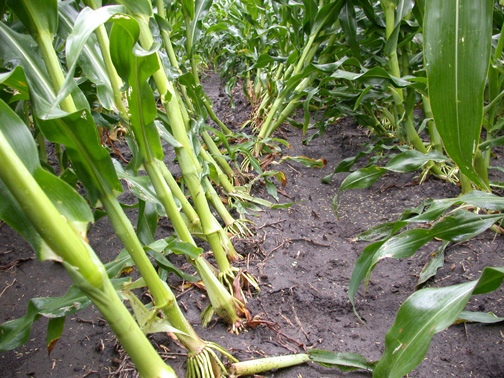With the recent heavy rains and winds in many parts of the state, it seems like a good time to talk about corn lodging. Corn lodging, during rapid vegetative growth and often just before pollination, is not a welcome sight. Unsurprisingly, it generally follows a storm front that has moved through the area…leading to spotty but striking damage on some farms. There are a variety of potential factors that can lead to lodging, and corn rootworm feeding is certainly one of them.
Shallow roots (e.g., compaction) and soggy soils coupled with high winds, rootworm feeding or any other issues that compromise roots can lead to lodging. If lodging is noted, it is typically easily to assess whether rootworms are to blame. To properly assess lodged plants, go to a damaged area, dig up roots with a shovel, clean off soil, and carefully examine the roots. Rootworm feeding is still happening now and not much regrowth will have occurred, so feeding scars and damage will be visible to the naked eye. You may even be lucky enough to see the larvae in action! Rootworm feeding is relatively easy to diagnose and not likely to be confused with other insect damage at this time of year – rootworm feeding scars are characterized by brown, often longitudinal, discolorations anywhere on the root system, but often is more serious towards the root tips. Scarring damage alone is not likely to reduce the root’s anchoring ability, however. Root pruning, especially with entire nodes (i.e. the “rings” of roots around the circumference of the stem) missing, would likely implicate rootworms as the cause of root lodging. Pruned roots will look ragged and necrotic at the tips. The video below will contrast two root systems with rootworm damage, representing heavy and minor feeding.
Another giveaway, usually later in season, will be the density of rootworm beetles flying about as you enter the field, as they will be emerging soon. In recent years, economic levels of rootworm feeding have been fairly uncommon in Indiana. If you are finding abundant western corn rootworm beetles in lodged fields, and Bt-RW corn was planted (most current Bt corn hybrids do express proteins targeting rootworm larvae), please contact your seed company personnel. Plants should be tested for the presence of the appropriate Bt protein. If the protein is being expressed by plants, and heavy feeding is noted, it may indicate a resistance issue that requires further follow-up.



